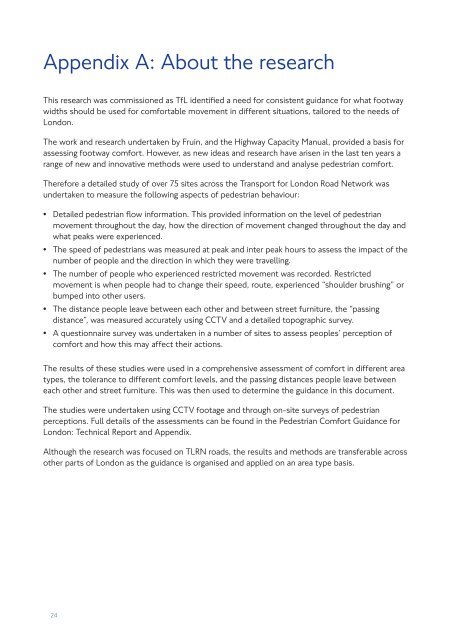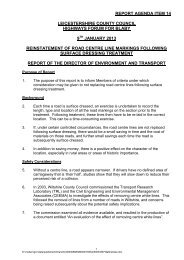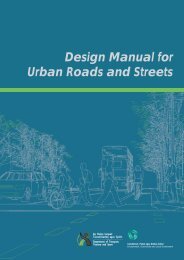Pedestrian Comfort Guidance for London
Pedestrian Comfort Guidance for London
Pedestrian Comfort Guidance for London
You also want an ePaper? Increase the reach of your titles
YUMPU automatically turns print PDFs into web optimized ePapers that Google loves.
Appendix A: About the research<br />
This research was commissioned as TfL identified a need <strong>for</strong> consistent guidance <strong>for</strong> what footway<br />
widths should be used <strong>for</strong> com<strong>for</strong>table movement in different situations, tailored to the needs of<br />
<strong>London</strong>.<br />
The work and research undertaken by Fruin, and the Highway Capacity Manual, provided a basis <strong>for</strong><br />
assessing footway com<strong>for</strong>t. However, as new ideas and research have arisen in the last ten years a<br />
range of new and innovative methods were used to understand and analyse pedestrian com<strong>for</strong>t.<br />
There<strong>for</strong>e a detailed study of over 75 sites across the Transport <strong>for</strong> <strong>London</strong> Road Network was<br />
undertaken to measure the following aspects of pedestrian behaviour:<br />
•<br />
•<br />
•<br />
•<br />
•<br />
Detailed pedestrian flow in<strong>for</strong>mation. This provided in<strong>for</strong>mation on the level of pedestrian<br />
movement throughout the day, how the direction of movement changed throughout the day and<br />
what peaks were experienced.<br />
The speed of pedestrians was measured at peak and inter peak hours to assess the impact of the<br />
number of people and the direction in which they were travelling.<br />
The number of people who experienced restricted movement was recorded. Restricted<br />
movement is when people had to change their speed, route, experienced “shoulder brushing” or<br />
bumped into other users.<br />
The distance people leave between each other and between street furniture, the “passing<br />
distance”, was measured accurately using CCTV and a detailed topographic survey.<br />
A questionnaire survey was undertaken in a number of sites to assess peoples’ perception of<br />
com<strong>for</strong>t and how this may affect their actions.<br />
The results of these studies were used in a comprehensive assessment of com<strong>for</strong>t in different area<br />
types, the tolerance to different com<strong>for</strong>t levels, and the passing distances people leave between<br />
each other and street furniture. This was then used to determine the guidance in this document.<br />
The studies were undertaken using CCTV footage and through on-site surveys of pedestrian<br />
perceptions. Full details of the assessments can be found in the <strong>Pedestrian</strong> <strong>Com<strong>for</strong>t</strong> <strong>Guidance</strong> <strong>for</strong><br />
<strong>London</strong>: Technical Report and Appendix.<br />
Although the research was focused on TLRN roads, the results and methods are transferable across<br />
other parts of <strong>London</strong> as the guidance is organised and applied on an area type basis.<br />
24




